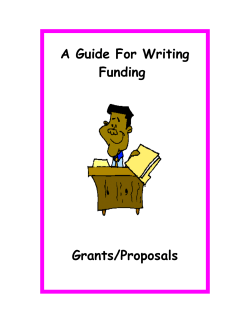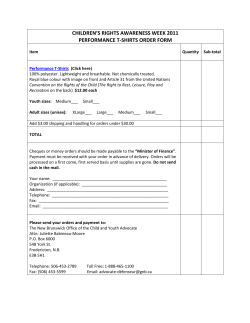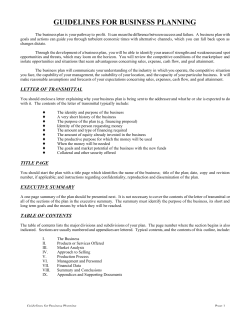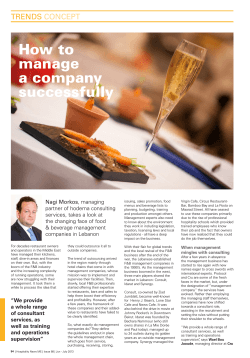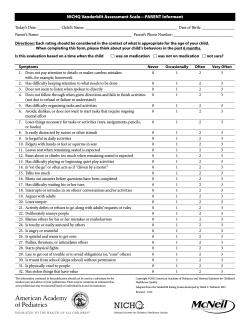
Proposal Writing What is a Proposal? 8/25/2008
8/25/2008 Proposal Writing Mohamed A. El-Sharkawi University of Washington Seattle, WA 98195 http://cialab.org What is a Proposal? Material in the following sections are obtained and modified from “GUIDE FOR WRITING A FUNDING PROPOSAL” by S. Joseph Levine Michigan State University http://www.LearnerAssociates.net Proposal • A document that presents the case for 1. An idea 2. An action one takes to materialize the idea • The proposal is a request for support to pursue the idea – – – – Support the investigator financially so they can free their time to work on the idea To provide support for other staff while working on the project To provide support for equipment and supplies directly used to perform the research To provide support for travel to attend technical meetings related to the research project Funding Agencies • Foundations investing in future technologies and improving societal wellbeing • Industry seeking solutions to their own manufacturing and business problems • Industry seeking new products and technologies to maintain competitiveness in world market • …… Investigator • Each proposal has at least one principal investigator (PI) and may include one or more co-principal investigator (co-PI). • PI is the main person conducting the research • Co-PI is the supporting researchers on the project Why would anyone pay someone to do research? • Almost all the comfort and technologies we enjoy today are the results of funded research • The developed nations are rich mainly because of their investment in research and their effective technology transfer. – The main difference between underdeveloped and developed countries is the quality of research they support. • Try living without things such as internet, vaccines, modern medicine, airplanes, televisions, automobiles, etc. 1 8/25/2008 Fact 1: Reviewers Facts to Keep in Mind Before Writing a Proposal • Your proposal is often read by one or two experts in your field. However, the program manager, and perhaps other reviewers are not experts. • Remedy: – You must write your proposal for their benefit too. Fact 2: Overwhelmed Managers • The program managers and panel members often see a large number of proposals • Remedy: – You have to grab your reader's attention from the beginning. Fact 3: Perfection • Your proposal may not be perfect • Remedy: – Keep a humble attitude – Ask people to suggest ways to improve your proposal. Don’t be defensive • If they misunderstand what you were trying to say, rewrite it to clear the misunderstanding • If they don't immediately see the merit of your proposal, rewrite it until they do. Fact 4: First Page-First Impression • It is safe to assume that many readers will get no further than the first page. • Remedy: – Make sure that the first page is a good summary of the entire proposal. – Don't fill it up with technical background. – Instead, address the following: • • • • • • • What are the Reviewers Looking for in a Good Proposal? what you want to do whether the idea is new why it is important why the proposed solution is sound why you should succeed how much it will cost …… 2 8/25/2008 Technical Criteria • The proposal should articulate a new idea • The proposal should address a wellformulated problem • The proposed work should be research, not just a routine application of known techniques • The problem should be important to the society Technical Criteria • The scale of the problem is large enough to require a special funding to solve it – if the problem can be solve quickly, or could be solved using the normal resources of a well-found laboratory, it is not a good proposal Technical Criteria Technical Criteria • The proposal must explain the idea in sufficient detail to convince the reader that the idea has some substance • The proposal must explain clearly what work will be done – The proposal should explain why there is reason to believe that it is indeed a good idea. – It is a mistake to merely identify a wish-list of desirable goals (a very common fault). There must be significant technical substance to the proposal. Non-technical Criteria • A PI with little existing research money could be placed ahead of a well-funded one. – On the other hand, existing funding provides evidence of a good track record. • There is merit in funding a proposal to keep a strong research team together – But it is also important to give priority to new researchers in the field. – What results are expected – How they will be evaluated – How would it be possible to judge whether the work was successful • The PIs much show evidence that they know about the work that others have done on the problem • The PIs should have a good track record, both of doing good research and of publishing it – A representative selection of relevant publications by the PIs should be cited. – Consistent failure to publish raises questions. – Absence of a track record is not necessarily damaging for young researchers Non-technical Criteria • Evidence of industrial interest in the proposed work is an indication for potential success. – Especially if the research is expected to produce a product • should usually include some industrial contribution to the project. – The case for support should include some marketing ideas • some thoughts about how the research will eventually become a product • identifying an industrial partner • Among the best proposals are the ones that address technology foresight of well established national entities. – including supporting quotes in your proposal 3 8/25/2008 Common Mistakes • The proposal is vague in key areas Common Mistakes – The question addressed by the proposal – The outcome of the research – The measure of success or failure – The contribution to human knowledge • The proposal lacks evidence of clear thinking – The formulation of the problem is poor – The planned solution is unclear or illogical Common Mistakes • The proposal doesn’t address the importance of the problem being addressed • The proposal is just a routine application of known techniques – The research funding agencies prefer sponsoring research instead of development works – Industry or venture capital are expected to fund development work • If no industry is interested then the question of the proposal has no commercial value. Common Mistakes • Sufficient technical details of the idea are not given – The reviewers are underwhelmed • The proposal is comprehensible to only expert in the field. – Some of the evaluators are not experts in all areas of the proposal. – A good proposal should be comprehensible to nonexperts, while also convincing experts that you know your subject. – Keep highly-technical material in specially marketed section – Avoid highly technical material in the introduction Common Mistakes • Other researchers have addressed the same problem and failed – There is no evidence that the PIs will succeed this time. – The goals must be substantiated by solid evidence of potential success • The proposal is written in such a way that gives the impression of "give us the money and we will figure out how to do the work” – Clearly state all of your ideas – Describe your preliminary work that shows evidence that the idea is good. • The proposal is heavy on showing off your good track record – Include a relevant list of publications in the appendix. Common Mistakes • The proposal did not address related research, even if you are dismissing it – The reviewers will think that the PIs are unaware of the state-ofthe-art – A common mistake is to give references only to your own work • The proposed research appears to have been done. – competitor solutions must be discussed and their inadequacies identified. • The PIs seem to be attempting too much for the funding requested and project time. – It is perceived as a lack of realism, poor understanding of the problem, or poor research methodology. 4 8/25/2008 Common Mistakes • The proposal is too expensive for the probable gain. – Expensive proposals are more likely to be rejected. • The proposal sounds like it might be done by a graduate student on the departmental computer. – These type of works should be funded by own institutions. – If the research institutions are not adequate, then this is taken to be a weak points against the PIs and the institution. Quiz • Mention 5 technical criteria for a well written proposal • Mention 4 non-technical criteria for a well written proposal • Mention 5 mistakes you should avoid Main Parts of a Proposal 1. 2. 3. 4. TITLE PROJECT OVERVIEW BACKGROUND INFORMATION/STATEMENT OF THE PROBLEM PROJECT DETAIL Goals & Objectives Clientele Methods Staff/Administration Main Parts of a Proposal 5. AVAILABLE RESOURCES/NEEDED RESOURCES Personnel Facilities Equipment/Supplies/Communication Budget 6. 7. Title/Cover Page • Funding agencies often have specifications for the Title Page – Signatures of key people in your organization such as the Department chair, Dean, and Contracts Officer – Collaborators from other organizations should be identified names on the Title/Cover Page • Your cover page should look professional and neat. – However, fancy report covers and expensive binding may send the wrong message that you do things rather expensively! • The title should be clear and unambiguous (do not make it cute) • The best titles are the ones that reads like micro abstracts. EVALUATION PLAN APPENDICES Title/Cover Page • The title should gives a quick image of the key ideas of your proposal – The words used in your title should clearly reflect the focus of your proposal. – The most important words should come first, then the less important words. – Remove words that are not necessary for understanding the merit of the proposal – Major word in the title should be in capital letters. – Try and use only a single sentence for your title. • Two part title can be used if a single sentence is not possible. • The two parts should be separated by a colon (use only as a last resort!) 5 8/25/2008 Titles: Example Example 1: Arrangement of the title • Title 1 – Neural Networks and their use for Power Grid Stability • Analysis of Title 1: – The focus is on Neural Network – Too many words connecting the two main clauses • Title 2 – Power Grid Stability using Neural Networks • Analysis of Title 2: – The focus is on Power Grid Stability – Less words are used to connect the two main clauses • Main Lessons: – Arrange the title so that the clause with the main idea is written before the others – Remove words from your title that really are not necessary for understanding the project ideas. Project Overview • The Project Overview should be an Executive Summary of the ideas – Executives are busy and they often have enough time to read just the overview • The Project Overview should be specific and concise. – Detail should be clarified at a later point in your proposal. • The Project Overview should give the correct information on your proposal in the mind of the reader, not the writer Project Overview Titles: Example Example 2: Simplicity Title 1 – Observing the Ocean Intrinsic Actions by Local Initiative to Create a Cable-based Underwater Power System Title 2 - Power System for Ocean Observatories Analysis: • Title 1 is too complex with unnecessary clauses • Title 2 is as informative as Title 1 Project Overview • The Project Overview is the framework of the rest of the proposal • The Project Overview should show your knowledge of the funding agency. – Your research project should address key concerns of the funding organization (community benefit, national strategic directions, etc.) – If you are collaborating with other organizations, their interests should also be highlighted in the Project Overview. Project Overview: Exercise • The Project Overview should be written after you have completed the entire proposal. – Only then you understand all aspects of your proposal • The Project Overview form a strong impression on your ideas. Do not give any of the following negative impressions: – – – – – – – – – Idea is not original Proposal is unfocused Rationale is weak Writing is vague Uncertain outcomes Does not have relevant experience Problem is not important Project is too large for the PIs …… • Using the attached Proposal, identify the main elements of the Overview. • Is the overview sufficiently informative? • What are missing? 6 8/25/2008 Background Information/Statement of the Problem • It is a review of relevant previous work – Cite previous work similar to what you are proposing. – Show that you know what you are proposing because you are knowledgeable of the-state-of-the-art. • Show how your project – extends the previous work – avoids the mistakes or shortcomings of earlier work – is unique • Be careful in your use of language. Minimizes the use of – – – – – – Jargons Confusing language Trendy words Abbreviations Colloquial expressions Redundant phrase Background Information/Statement of the Problem • Show how the problems you are addressing will help the potential funding agency in fulfilling their own goals and objectives. – As you write, keep the funding agency in your mind as a "cooperating partner" committed to the same concerns that you are. • Show any special reason that your organization is uniquely suited to conduct the project – Geographic location, expertise, prior involvements in this area, close relationship to the project clientele, etc. Background Information/Statement of the Problem: Exercise • Using the attached proposal, identify the main elements in the background section. • Is the background section sufficiently informative? • State any idea to improve on the background section? Background Information/Statement of the Problem • Show that your proposed work is definitely needed and should be funded – You will need to substantiate your claims • You should address the following questions – What are the pressing problems that you want to address? – How do you know these problems are important? – What other sources/programs similarly consider these needs as major? • Check to see that the potential funding agency is committed to the same problems that your proposal is addressing Background Information/Statement of the Problem • In the following sections of the proposal, it is important to refer back to the needs you've identified in this section – show how your methods will respond to these needs. • It is advantageous to show that you have already taken some small steps to begin your project – An excellent small step that can occur prior to requesting funding is a need assessment that you conduct (survey, interviews, focus groups, etc.). – Write up your need assessment as a short report, cite the report in your proposal, and include a copy with the proposal. Projects Details: Goals and Objectives • Goals are the large statements of what you hope to accomplish – usually aren't very measurable – create the setting for what you are proposing. • Objectives are operational – gives specific things you will be accomplishing in your project – are measurable. – form the basis for the activates of your project – serve as the basis for the evaluation of your project 7 8/25/2008 Projects Details: Goals and Objectives • Try and differentiate between your goals and your objectives - and include both. • Present measurable objectives for your project – If you are dealing with engineering problems, it is easier for the objectives to be measured – Abstract ideas are hard to measure. Projects Details: Examples of Goals and Objectives • Goal: – To build underwater observatory • Objectives: – Build underwater power network – Feed the power network from two shore stations – Provide interface between power network and science equipment • Show that there is considerable overlap between the goals and objectives for your proposal and the goals and objectives of the funding organization. – If there is not a strong overlap, find another funding agency Projects Details: Clientele Goals and Objectives: Exercise • Identify the goals and objectives in the attached proposal. • Identify the weaknesses and strength in the text and provide your own opinion on how to improve on it. • Identify your clientele (beneficiaries of your work) – Who are they? – Who is included in the clientele group? • Show your relationship with the clientele group • Show that you have the support of the clientele group to move ahead with the project • If members of the clientele group were involved in the preparation of the proposal, state that • Show why it is important for the funding agency to be supportive of your clientele. – How assisting your clientele is in the best interests of the funding agency. Projects Details: Methods • There should be a very clear link between the methods you describe in this section and the objectives you have previously defined. – Be explicit and state exactly how the methods you have chosen will fulfill your project's objectives • The funding agency will examine your methods looking for Projects Details : Exercise • What are the weaknesses and strength of the project details in the attached proposal? – what is new in your proposal – what is unique or innovative. – the importance of the proposed method to the solution • Clearly indicate how the methods allow the outcomes of your project to have value beyond your own project. 8 8/25/2008 Projects Details: Staff/Administration Projects Details: Staff/Administration • Describe the roles of the different people associated with your project and the importance of each. • If you will be using a Steering Committee (Advisory Committee, Governing Board, etc.) to assist in your project, describe how it will be organized and who will be included – The validity for what you are proposing is directly related to the people who will work with the project. – how each of the roles are essential to the success of the project • So what do you say about your key people? – Include their name, title, experience, and qualifications. – The descriptions of your personnel should let the funding agency know that you have excellent people who are committed to the project. • Funding agencies often like to see team work – A Steering Committee can be politically very helpful to you and your project. – You can enlist the support of a variety of other agencies/organizations by placing a representative of these agencies/organizations on your Steering Committee. – Define the length of service for the members of the Steering Committee to minimize the length of service of someone who may not be helpful! – A viable Steering Committee can suggest to a funding agency that • the project has strong links to the community • the project has a good chance of continuing after the funding period is over Staff : Exercise • Evaluate the staff section in the attached proposal. Available Resources • Collaborative efforts are considered very favorably! – Many funding agencies like to see cooperative ventures as the basis for community interest. – Project funding is coming from different sources which minimizes the risk taken by any one agency – Local resources could be hidden (in-kind) • • • • time that volunteers donate to your project materials that local merchants may provide local experts who can provide help/advise when needed a friend who is willing to do some word processing, etc. – in-kind resources can show the funding agency that you are strongly rooted in your community. Available Resources • It is very impressive to the funding agency if local resources have already been contacted and plans to include them in the project have already been made. – Letters from local resources supporting the project (included in the Appendix) are an excellent addition to the proposal. Available Resources • Provide a brief description of the facilities that will be used for the project. – Lab space – Equipment – Technical support • Consider describing existing facilities as in-kind contributions to the project. – free access to classrooms – meeting space at a libraries – project room in a local office building • It can be helpful to indicate how much additional money the funding agency would have to provide if these facilities were not donated 9 8/25/2008 Available Resources : Exercise • Evaluate the available resources in the attached proposal. Needed Resources: Personnel • Identify the people who will be paid from the grant – Include short descriptions of each of them – Make sure that the people are ideally suited to conduct the research • Instead of having all full-time staff on the project, consider having a number of part-time staff – especially if the part-time staff currently work with other cooperating organizations. • Make sure you notify people who you identify in your Personnel section and receive their approval before you send in your proposal. Needed Resources: Facilities • Identify any facility that you need for the project • Show why it is not reasonable to assume that these facilities should exist in your research institute • Justify the cost of the new facilities – – – – Long term use Broader use Cost centers …… Needed Resources: Equipment/Supplies/Communication • List the equipment needed for your project. – Be aware that funding agencies are usually much more willing to provide funds for the support of personnel than they are to support the purchase of equipment • Types of equipment that may be needed for a funded project: • computer/monitor/printer (for general project support) • tape recorder (for recording interviews, dictating reports, etc.) • video cassette recorder and television monitor (for recording project activities, documenting change, etc.) • desks/chairs/tables • telephone conferencing equipment • photocopy machine Needed Resources: Equipment/Supplies/Communication Needed Resources: Equipment/Supplies/Communication • Whatever you purchase on the project, should be solely used in the project • Find the actual cost of the equipment you need. • Cost of sharing information with others should be included. – Guessing the cost can be challenged by the funding agency • Be sure to include supplies such as stationery, postage, word processing software, and pencils/pens • Coffee, cups, cakes or other "supplies" for morning and afternoon breaks are usually not funded – Newsletter, website, video conferencing, workshops, etc. • The more open you are and willing to help others learn from your experiences the more likely a funding agency will be interested in your proposal. – Hosting some form of workshop on the area of research is a good way to publicly recognize your funding organization. – Invite someone from the funding organization to attend the workshop so they can hear what others think about the investment they have made. 10 8/25/2008 Needed Resources : Exercise • Evaluate the needed resources in the attached proposal Evaluation Plan • Include formative evaluation and summative evaluation – Formative evaluation: feedback on the project while it is being conducted – Summative evaluation: whether the project fulfilled its proposed objectives Evaluation Plan • Describe how you will decide whether or not your project has been successful and has achieved its objectives • The Evaluation Plan will tell the prospective funding agency how you will be going about showing them at the end of the project that their investment in you was a good one. • If you plan to use a survey or questionnaire to help in evaluating the success of your project, you may want to include in the Appendices a draft of what you are considering for the questionnaire/survey. Evaluation Plan • Create a summative evaluation plan if you have done a good job of clearly stating your project objectives or expected outcomes. – Make direct reference to your objectives in your evaluation plan. – The reader of your proposal will now be hearing the same message repeated in different sections of your proposal • A good evaluation plan should include some sense for what goes on following the conclusion of the funding period. – How will the initiatives that have been started under the project be sustained? – Have new things occurred that will be continued in the future? – How will other cooperating agencies assist in continuing the project after the conclusion of the funding period? Evaluation Plan : Exercise Needed Resources: Budget • Make your budget realistic. • Access the evaluation plan of the attached proposal – Request what you exactly need to carry out the project – Funding agencies can easily tell when someone has inflated a budget • Have a fiscal specialist in your organization review your budget to see how realistic you are. 11 8/25/2008 Needed Resources: Budget • Phase-up the project – It is not realistic to expect a new project to spend large amounts of money during the first 6 months of operation – Ask for a small amount of funding for the first phase of the project • Specify in your proposal what you expect to achieve during this "minimal funding” phase • Return to the funding agency and ask for funds for the next phase. – The funding agency will be able to assess your success – It is essential for you to make sure the first phase IS successful Needed Resources: Budget Needed Resources: Budget • Check with the agency to see if they have suggested/required budget categories that they want you to use • If the potential funding agency doesn't have any budget requirements, organize your budget around a set of meaningful categories that work for the project you are proposing. Needed Resources: Budget • Categories that you may want to consider for itemizing your budget are: – – – – – – – – – – Year 1 Year 2 Year 3 Personnel (salary and benefits) Consultants (salary) Equipment Supplies Materials preparation Travel Rental of facilities Evaluation Other expenses Indirect costs (costs that your organization requires that you include) Needed Resources: Budget PERSONNEL . . . Person #1 . . . Person #1 . . . Person #3 . . . Sub-Total . . . SUM TOTAL . Needed Resources: Budget Year 1 Year 2 Year 3 COMMUNICATION (list) . . . Year 1 Year 2 Year 3 Telephone . . . FACILITIES (list) . . . Postage . . . Sub-Total . . . Sub-Total . . . EQUIPMENT (list) . . . TRAVEL (list) . . . Sub-Total . . . Fuel . . . SUPPLIES (list) . . . Vehicle Rental . . . Sub-Total . . . Rail Tickets . . . Sub-Total . . . . Year 1 Year 2 Year 3 TOTAL . SUM TOTAL . . . 12 8/25/2008 Budget : Exercise • Write a budget for a project with a total amount not exceeding LE150,000. Appendices • Appendices should be devoted to those aspects of your project that are of secondary interest to the reader. • Examples of Appendices Items: – Dissemination Plan - An important aspect of your proposal is your plan for disseminating information of/from the project to others – Time Line - A clear indication of the time frame for the project and the times when each aspect of the project will be implemented. Try creating the time line as a graphic representation – Letters of Support - Funding agencies would like to know that others feel strongly enough about your project that they are willing to write a letter in support of the project. • Do not write the letters for the agencies - they will all sound alike and will probably defeat your purpose of using them. • The letters must be substantive. If not, do not use them! • Have the letters addressed directly to the funding agency. (Do not use a general "To Whom It May Concern" letter Appendices • Examples of Appendices Items: – Cooperating Agency Descriptions – • Provide a more detailed description of each of these agencies • Give the name/address of the agency, names of key personnel, and brief descriptions of the major services provided is sufficient. – Evaluation Instrument - Include a draft copy of the actual evaluation instrument you plan to use (survey, questionnaire, interview guide, etc.). • Indicate DRAFT at the top of the instrument and then make it look as real as possible. • Never say things like, "I think I may have a question that deals with...", or "Four or five questions will be included that examine the concern of...". • If you will be using an interview procedure or a focus group discussion, include a draft copy of the specific questions that will actually be used for the interview/discussion. 13
© Copyright 2025
